Though Kratos is best known today as the protagonist in the God of War video game series, the ancient legend surrounding the Greek deity is quite different.
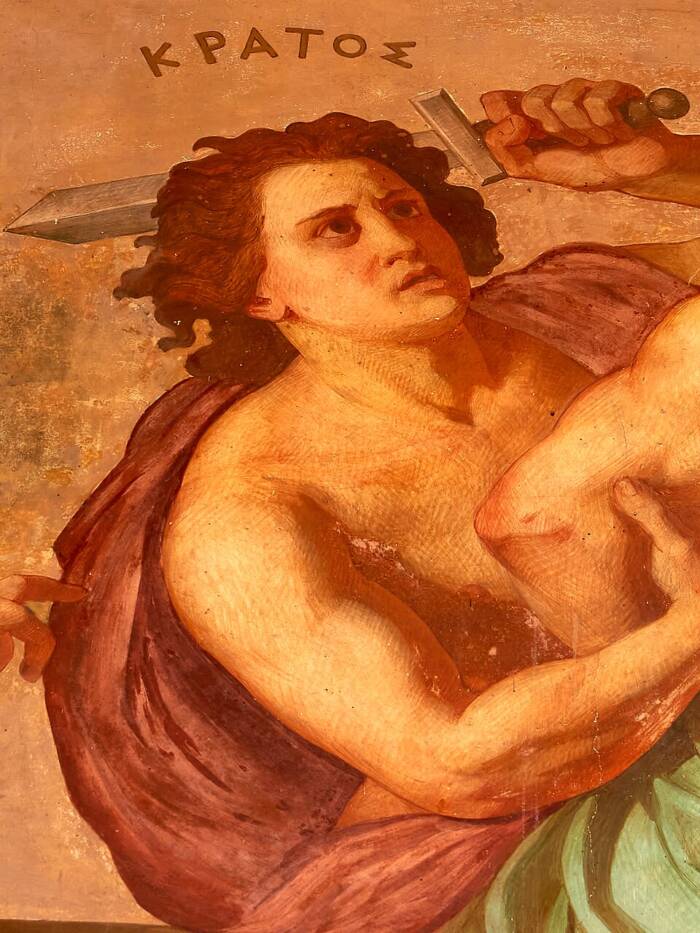
Wikimedia CommonsA mural of the Greek god Kratos at the University of Athens.
There’s no question that Greek mythology is prevalent in modern storytelling. Whether it’s the Percy Jackson book series, Broadway musicals, or video games, figures of these ancient stories are everywhere.
Some characters have become detached from their original tales, gaining more popularity for their new roles in modern media. This is certainly the case for Kratos, the divine personification of strength in Greek mythology.
Kratos is probably best known today for his role in the God of War video games. In ancient Greek legends, his story is quite a bit different.
Who Was Kratos In Greek Mythology?
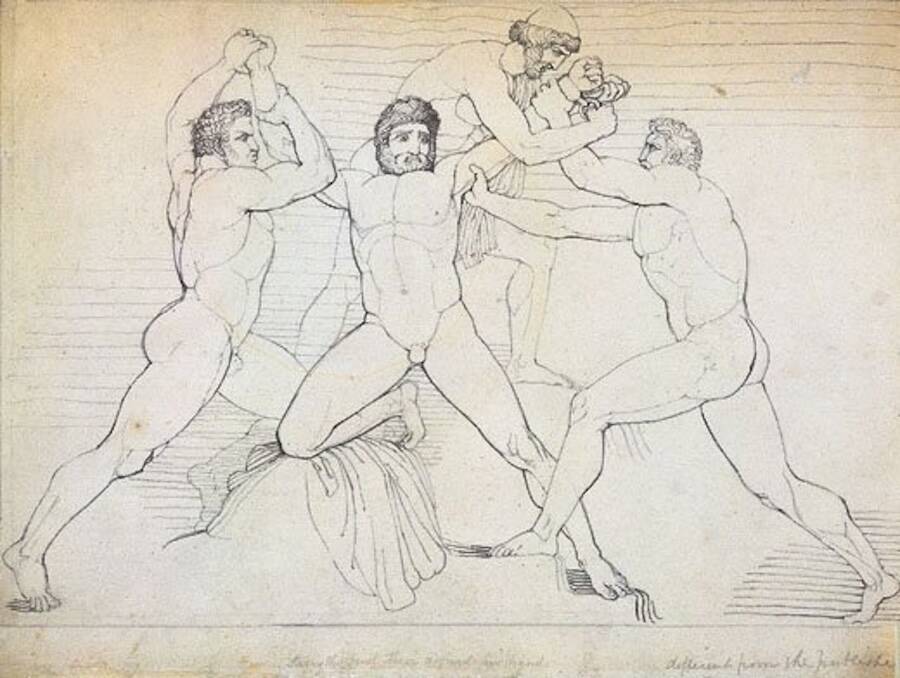
John Flaxman Jr./Wikimedia CommonsThe most famous myth featuring Kratos is the story of how Prometheus was punished for giving humanity fire.
Kratos was the son of the Titan Pallas and the Oceanid Styx. Kratos’ name means strength, and as a figure of Greek mythology, he came to be known as the divine personification of strength. Though he was a relatively minor god in the Greek pantheon, it’s clear that he was very powerful.
Kratos had three siblings, all of whom represented similarly powerful traits. His brother Zelus embodied achievement, dedication, and, as his name might imply, zeal. His sister Bia symbolized force and raw energy, while his other sister Nike was the divine personification of victory.
Together, the siblings called the Palace of Zeus on Mount Olympus their home, always ready to enforce the will of Zeus, the king of all the Greek gods. Kratos and his siblings were depicted as being constantly at Zeus’ side.
Kratos and his siblings were mentioned in Theogony, a work by the Greek poet Hesiod. Written in the late eighth or early seventh century B.C.E., the epic poem explains how devoted the siblings were to serving Zeus’ will:
“They have no house but the house of Zeus, no seat, and no path besides the one the god gives them, and always sit beside thundering Zeus.”
As Zeus was preparing for the Titanomachy, the war between the old Titans and the rising Olympian gods, he recruited many allies to win the conflict. Kratos’ mother, Styx, was one of the first deities to answer Zeus’ call.
Styx brought her four children with her, and in gratitude for her help, Zeus declared that her children would always have a place with him in his palace. Since Styx was one of the first gods to join up with the Olympians, Zeus gave her children a high position, serving as his powerful enforcers.
As An Enforcer Of Zeus, Kratos Helped Carry Out The Punishment Of Prometheus
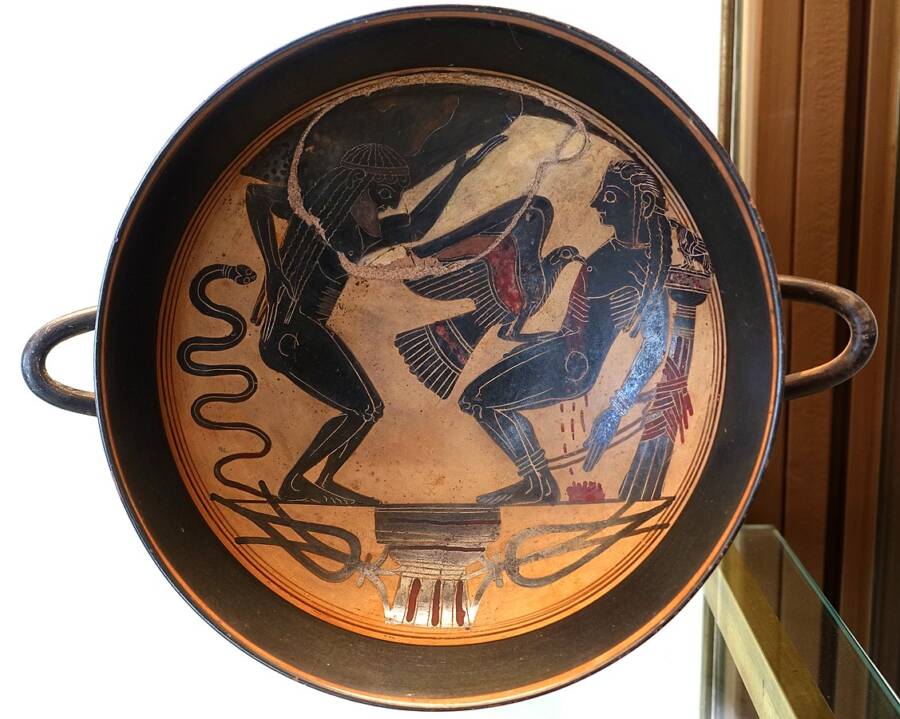
Wikimedia CommonsA depiction of the Titan Prometheus, who famously fell out of favor with Zeus.
The most well-known story from Greek mythology featuring Kratos is the tale of Prometheus, the Titan who introduced humans to fire.
Despite being a Titan, Prometheus had sided with Zeus during the Titanomachy war. However, Prometheus would not remain in Zeus’ favor.
After his victory in the Titanomachy, Zeus resolved to keep a then-primitive humankind as weak and subservient as possible, punishing them whenever they didn’t worship the gods properly. Prometheus didn’t agree with this plan, especially since he played a key role in creating humanity.
He soon introduced humans to fire, as well as math, navigation, and the arts, going against the will of Zeus. As punishment, the king of the gods ordered Prometheus to be chained to a large rock in unbreakable bonds.
As recounted in the play Prometheus Bound by Aeschylus, Kratos and his sister Bia brought the Titan to the mountains to face Zeus’ punishment.
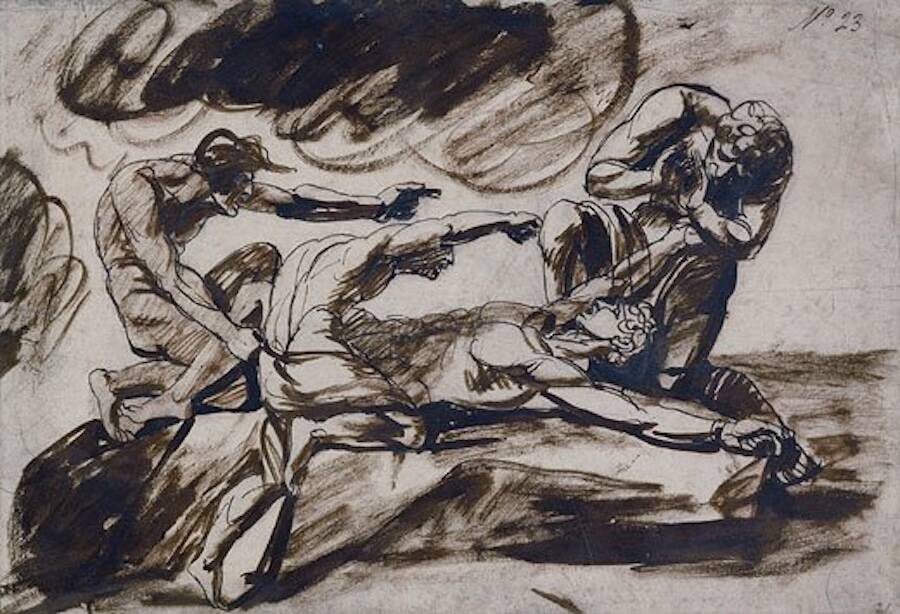
George Romney/Wikimedia CommonsThere have been many illustrations depicting Prometheus being chained to a rock throughout history.
In the play, Kratos and Bia take Prometheus to Hephaestus, the divine smith and the god of fire, who must be the one to ultimately chain Prometheus to the rock. However, Hephaestus is clearly hesitant to do so.
This leads to a back-and-forth discussion between Hephaestus and Kratos, in which they agree that Zeus’ treatment of Prometheus has been oppressive, but that no one other than Zeus is truly free under Zeus’ rule.
As the play continues, Kratos eventually convinces Hephaestus to chain up Prometheus. Kratos is depicted as being particularly brutal in enforcing Zeus’ will. In many tellings of the myth, Kratos is portrayed as merciless, causing unnecessary wounds, and serving as a cruel extension of Zeus’ rule.
In the end, Prometheus wasn’t just chained to the rock, he was also nailed down and he had a steel wedge driven through his chest. As an immortal being, Prometheus wouldn’t be killed by this torture — but he would be forced to endure seemingly endless agony. (According to most versions of the myth, Zeus eventually allowed the hero Heracles to free Prometheus.)
Notably, Nike and Zelus are absent from the play, likely because their traits do not represent the most tyrannical or oppressive aspects of Zeus’ rule.
Kratos In God Of War And Other Modern Interpretations
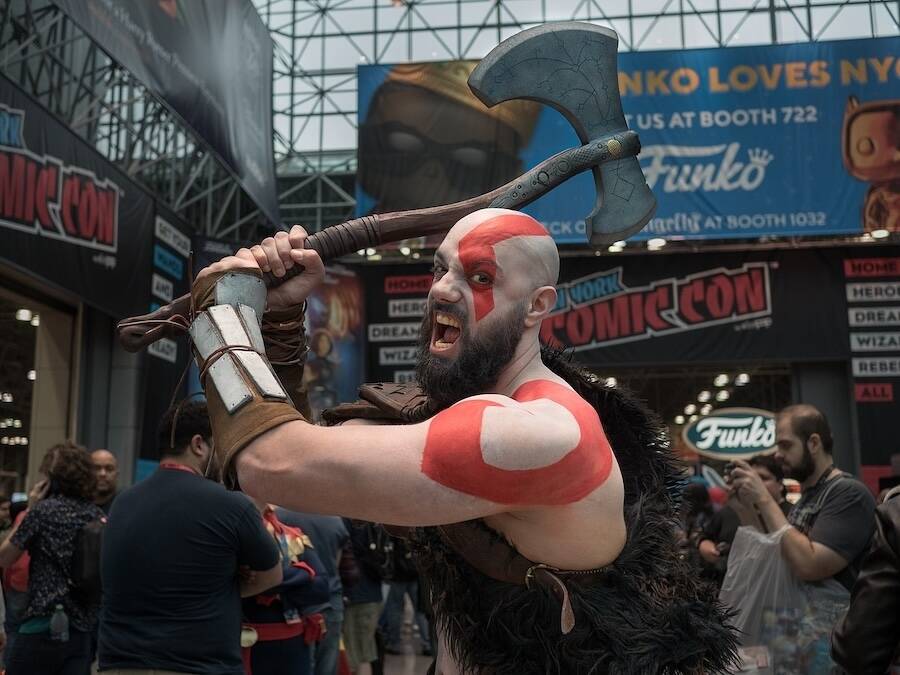
Rhododendrites/Wikimedia CommonsA cosplayer dressed up as the Kratos character from God of War.
Kratos appears sparingly in Greek myths beyond the story of Prometheus. And when he does appear, he’s often assisting other gods in battle, rather than playing a key role on his own. Ancient physical depictions of Kratos were also rare, but he was often imagined as a winged enforcer of Zeus.
Often, it seemed like Kratos appeared as more of an idea than a fully fleshed-out character in Greek mythology, especially during antiquity.
It wasn’t until the 18th century that Kratos started to see more notoriety. Then, the scholar Thomas Morell released an English translation of Prometheus Bound. This inspired more artists to draw Kratos.
Then, in 1820, Percy Bysshe Shelley took inspiration from the Prometheus myth for his drama Prometheus Unbound. Kratos also makes an appearance in Gabriel Fauré’s grand cantata Prométhée, which premiered in 1900.
Today, Kratos is most well-known for being the name of the protagonist in the God of War video game series. However, the modern character wasn’t originally meant to be a depiction of the ancient Greek god.
In fact, the creators of the game were reportedly unaware that Kratos belonged to the Greek pantheon. They were simply inspired by the Greek word for “strength” and wanted to demonstrate how powerful the character was — and they later called the naming coincidence a “happy mistake.”
But of course, the original deity was quite different from the God of War character. For one thing, Kratos was the god of strength, not war. And the video game character is often said to be more similar to other figures from Greek mythology, especially Heracles and Perseus (who slayed Medusa).
Though both versions of Kratos are clearly strong and mighty, and not afraid of violent situations, the video game version of Kratos is a surprisingly complex antihero, with recent games focusing on Kratos’ relationship with his son and themes of fatherhood and redemption.
Obviously, the video game series offers a much deeper dive into its protagonist than ancient Greek myths did with such a minor divine figure. Because of this, it might be easy for modern readers to interpret the original Kratos from antiquity as simply cruel, or at least as an extension of Zeus’ tyranny. But interestingly, the myths themselves often leave it open to interpretation as to whether Kratos goes too far in enforcing Zeus’ will.
Either way, the spirit of Kratos’ fearsome power clearly continues on.
After reading about Kratos from Greek mythology, go inside the historical debate over whether the legendary Trojan Horse actually existed. Then, discover 33 little-known facts about ancient Greece.





